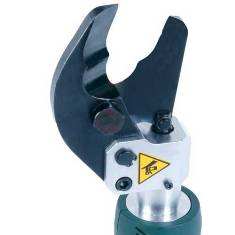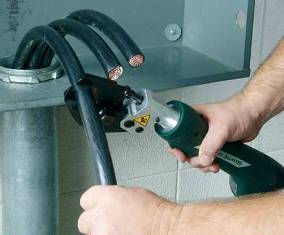Technology and tools for cutting, pulling and installing cables
Removing cables
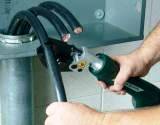 The cable stripping process consists of multi-stage removal of protective coatings, sheaths, shields, insulation and shielding. The dimensions of the cutting boundaries are determined by the technical documentation. It depends on the construction of the cable, the sleeve to be installed, the calculated voltage of the cable and the cross-section of the wires. Of course, this job requires a special cable stripping tool.
The cable stripping process consists of multi-stage removal of protective coatings, sheaths, shields, insulation and shielding. The dimensions of the cutting boundaries are determined by the technical documentation. It depends on the construction of the cable, the sleeve to be installed, the calculated voltage of the cable and the cross-section of the wires. Of course, this job requires a special cable stripping tool.
When removing the cable, it is important that the paper insulation at the ends is dry. If it is wet, remove a piece of cable until it dries. Next, the location of the dressings is determined. The required distance is straightened, the resin strip is rolled up, a steel wire bandage is applied using a cage — a special device. The ends of the wire are twisted or bent to the cable with pliers.
The outer cover is screwed to the tape, but not cut off. Then it will be useful to protect the clutch from corrosion. Another is installed at a distance of 50-70 mm from the first bandage.The upper and lower strips are cut along its upper edge with a hacksaw or armored cutter, slightly larger than their thickness. Then the armor is unrolled and ripped off.
The cable paper and bitumen mixture are then heated with an open flame on a torch or propane torch. The cable sheath is cleaned with a cloth soaked in heated transformer oil. At a distance of 50-70 mm from the cut of the bumper, ring-shaped cuts are made. They are applied with an electric knife. But it is better to do this with a special tool for stripping the cable — a knife with a cut depth limiter. Cuts are made at a distance of 10 mm, the strip of shell between them is removed with pliers. At a distance of 10 mm, another cut is made, the shell is completely removed to the end of the core.
If the cable has an aluminum sheath, then it is better to make the cuts with an NKA-1M knife. In this case, a spiral slot is made from the second slot in a circle. After cutting the corrugation at a distance of 19-15 mm from the protrusion, it is removed. It remains only to remove the insulation from the wire and bend them.
Tools for installation, disassembly of cables
For cutting the ends of cables, removing insulation, connecting wires, universal sets of tools are used. And the tools included in the kit are also multi-purpose. But in each specific case it is necessary to add or remove something. Technological operations often require consideration of ambient temperature, type of work (outdoor or indoor), brands of dogs, type of insulation, screen.
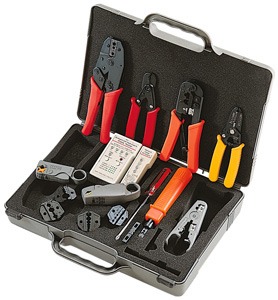
For example, to cut a cable with paper insulation, you need a cable stripping tool: an insulation knife, a special knife for removing the aluminum and lead sheath, a roller and beads. And if the cable is plastic insulated, you'll need a tool to strip the cable insulation — a plastic knife, heat shrink, torches, PVC pipe welders, etc.
One of the universal tools is manual, automatic and semi-automatic dressing rooms. They allow not only to remove the insulation from wires with a cross section of 0.2 to 6 mm, but also to bite them off. In addition, as a rule, they combine several tools: pliers, screwdriver. Adjustments and limitations make working with a cable stripping tool simple and easy. This is due to the use of the lever principle in the design of the tool. But this principle is slightly modified by springs.
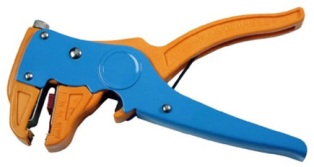
Not only the dismantling, but also the installation of cables can be done faster if you use a special tool. With his help, the work goes not only faster, but also better. The installation tool is divided into three types: multi-wire cable tool, press jaw and hand tool. A conventional tool forces most of the work to be done by hand, due to arm muscle strength. But even slightly improved, it allows you to do it with the help of springs built into the cable connection tool. It is enough just to squeeze it all the way, and then, as a result of the release, the working parts act correctly on the cable.
In most crimping jaws there are several blades and they are interchangeable, which makes it possible to work with one tool for removing cable insulation with cables of different purposes and different cross-sections of wires. In addition, they also perform the operation of trimming the excess ends of the wires. You don't need to take another tool, tweezers and do it separately. Everything is cut in one motion.
Typically, the cable installer is equipped with ergonomic handles that allow you to work exactly where you need to. Thanks to their design, it is possible to work in hard-to-reach places, in close proximity to the walls.
Crimping the wires in the connector using a special tool also becomes a simple procedure. After all the wires are removed at the same level in one movement, it is enough to insert them into the sockets of the connector and simply squeeze the tool. The bending of the wires and the trimming of the excess ends occur at the same time.
Each cable tool is made of high-quality steel, with stiffening ribs in the necessary places. For continued trouble-free operation, it is recommended to lubricate the rubbing parts and to clean the entire tool from dust and dirt after the work is completed. If necessary, the working surfaces can be treated with solvents.
Wiring
Laying the cable is impossible without special tools to facilitate this work.And if ordinary tools are used to connect drums with cables: levers, nail pullers, axes and shears for metal, then when laying you can not do without special devices for gripping the cable.
This cable puller works on a very simple "loop" principle: when the cable is pulled, they decrease in diameter and trap the end of the cable inside themselves. During the pull, the clamping rings move in the opposite direction of the movement and compress the cable even more. For pulling cables through pipes or narrow passages, the use of a special clamp is recommended. The cable is fixed inside it, and the cable is attached to the grip hole.
All necessary equipment and tools are located along the track, seated and secured. The winch that pulls the cable must be equipped with a dynamometer to control the pulling forces. At the slightest threat of cable breakage or internal breakage of wires, the laying stops immediately, the cause of the stretch is established, and only after its removal the continuation continues.

